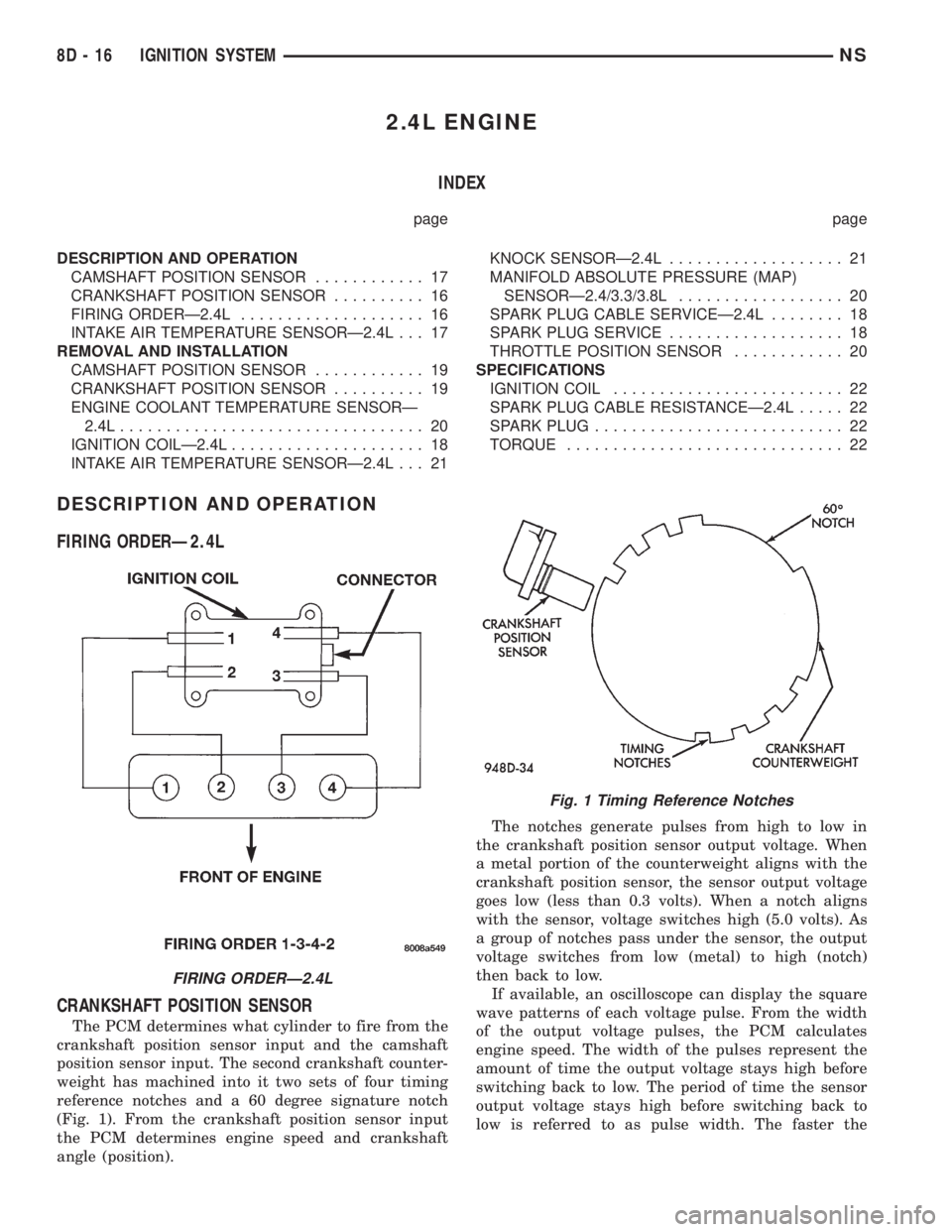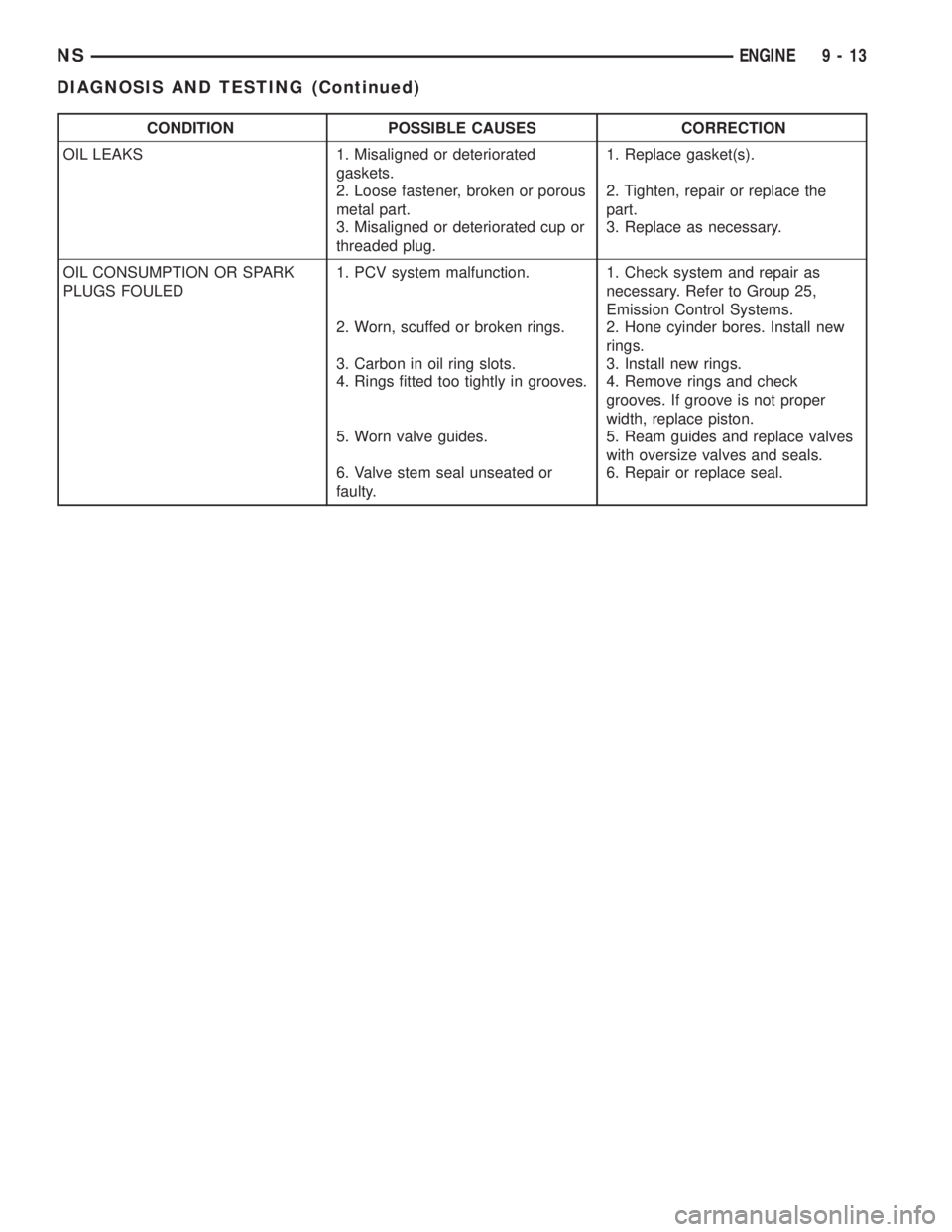width CHRYSLER VOYAGER 1996 Service Manual
[x] Cancel search | Manufacturer: CHRYSLER, Model Year: 1996, Model line: VOYAGER, Model: CHRYSLER VOYAGER 1996Pages: 1938, PDF Size: 55.84 MB
Page 305 of 1938

THROTTLE POSITION SENSOR (TPS)
The TPS mounts to the side of the throttle body
(Fig. 13).
The TPS connects to the throttle blade shaft. The
TPS is a variable resistor that provides the Power-
train Control Module (PCM) with an input signal
(voltage). The signal represents throttle blade posi-
tion. As the position of the throttle blade changes,
the resistance of the TPS changes.
The PCM supplies approximately 5 volts to the
TPS. The TPS output voltage (input signal to the
powertrain control module) represents throttle blade
position. The TPS output voltage to the PCM varies
from approximately 0.40 volt at minimum throttle
opening (idle) to a maximum of 3.80 volts at wide
open throttle.
Along with inputs from other sensors, the PCM
uses the TPS input to determine current engine oper-
ating conditions. The PCM also adjusts fuel injector
pulse width and ignition timing based on these
inputs.
LOCK KEY CYLINDER
The lock cylinder is inserted in the end of the
housing opposite the ignition switch. The ignition key
rotates the cylinder to 5 different detents (Fig. 14):
²Accessory
²Off (lock)
²Unlock
²On/Run
²Start
KNOCK SENSOR
The knock sensor threads into the side of the cyl-
inder block in front of the starter motor. When the
knock sensor detects a knock in one of the cylinders,
it sends an input signal to the PCM. In response, the
PCM retards ignition timing for all cylinders by a
scheduled amount.
Knock sensors contain a piezoelectric material
which constantly vibrates and sends an input voltage
(signal) to the PCM while the engine operates. As the
intensity of the crystal's vibration increase, the knock
sensor output voltage also increases.
Fig. 12 Engine Coolant Temperature SensorÐ3.3/
3.8LFig. 13 Throttle Position Sensor and Idle Air Control
Motor
Fig. 14 Ignition Lock Cylinder Detents
NSIGNITION SYSTEM 8D - 7
GENERAL INFORMATION (Continued)
Page 314 of 1938

2.4L ENGINE
INDEX
page page
DESCRIPTION AND OPERATION
CAMSHAFT POSITION SENSOR............ 17
CRANKSHAFT POSITION SENSOR.......... 16
FIRING ORDERÐ2.4L.................... 16
INTAKE AIR TEMPERATURE SENSORÐ2.4L . . . 17
REMOVAL AND INSTALLATION
CAMSHAFT POSITION SENSOR............ 19
CRANKSHAFT POSITION SENSOR.......... 19
ENGINE COOLANT TEMPERATURE SENSORÐ
2.4L................................. 20
IGNITION COILÐ2.4L..................... 18
INTAKE AIR TEMPERATURE SENSORÐ2.4L . . . 21KNOCK SENSORÐ2.4L................... 21
MANIFOLD ABSOLUTE PRESSURE (MAP)
SENSORÐ2.4/3.3/3.8L.................. 20
SPARK PLUG CABLE SERVICEÐ2.4L........ 18
SPARK PLUG SERVICE................... 18
THROTTLE POSITION SENSOR............ 20
SPECIFICATIONS
IGNITION COIL......................... 22
SPARK PLUG CABLE RESISTANCEÐ2.4L..... 22
SPARK PLUG........................... 22
TORQUE.............................. 22
DESCRIPTION AND OPERATION
FIRING ORDERÐ2.4L
CRANKSHAFT POSITION SENSOR
The PCM determines what cylinder to fire from the
crankshaft position sensor input and the camshaft
position sensor input. The second crankshaft counter-
weight has machined into it two sets of four timing
reference notches and a 60 degree signature notch
(Fig. 1). From the crankshaft position sensor input
the PCM determines engine speed and crankshaft
angle (position).The notches generate pulses from high to low in
the crankshaft position sensor output voltage. When
a metal portion of the counterweight aligns with the
crankshaft position sensor, the sensor output voltage
goes low (less than 0.3 volts). When a notch aligns
with the sensor, voltage switches high (5.0 volts). As
a group of notches pass under the sensor, the output
voltage switches from low (metal) to high (notch)
then back to low.
If available, an oscilloscope can display the square
wave patterns of each voltage pulse. From the width
of the output voltage pulses, the PCM calculates
engine speed. The width of the pulses represent the
amount of time the output voltage stays high before
switching back to low. The period of time the sensor
output voltage stays high before switching back to
low is referred to as pulse width. The faster the
FIRING ORDERÐ2.4L
Fig. 1 Timing Reference Notches
8D - 16 IGNITION SYSTEMNS
Page 315 of 1938

engine is operating, the smaller the pulse width on
the oscilloscope.
By counting the pulses and referencing the pulse
from the 60 degree signature notch, the PCM calcu-
lates crankshaft angle (position). In each group of
timing reference notches, the first notch represents
69 degrees before top dead center (BTDC). The sec-
ond notch represents 49 degrees BTDC. The third
notch represents 29 degrees. The last notch in each
set represents 9 degrees before top dead center
(TDC).
The timing reference notches are machined to a
uniform width representing 13.6 degrees of crank-
shaft rotation. From the voltage pulse width the
PCM tells the difference between the timing refer-
ence notches and the 60 degree signature notch. The
60 degree signature notch produces a longer pulse
width than the smaller timing reference notches. If
the camshaft position sensor input switches from
high to low when the 60 degree signature notch
passes under the crankshaft position sensor, the
PCM knows cylinder number one is the next cylinder
at TDC.
The crankshaft position sensor mounts to the
engine block behind the generator, near the oil filter
(Fig. 8).
CAMSHAFT POSITION SENSOR
The PCM determines fuel injection synchronization
and cylinder identification from inputs provided by
the camshaft position sensor and crankshaft position
sensor. From the two inputs, the PCM determines
crankshaft position.The camshaft position sensor attaches to the rear
of the cylinder head (Fig. 2). A target magnet
attaches to the rear of the camshaft and indexes to
the correct position (Fig. 3). The target magnet has
four different poles arranged in an asymmetrical pat-
tern. As the target magnet rotates, the camshaft
position sensor senses the change in polarity (Fig. 4).
The sensor output switch switches from high (5.0
volts) to low (0.30 volts) as the target magnet rotates.
When the north pole of the target magnet passes
under the sensor, the output switches high. The sen-
sor output switches low when the south pole of the
target magnet passes underneath.
INTAKE AIR TEMPERATURE SENSORÐ2.4L
The intake air temperature sensor measures the
temperature of the air as it enters the engine. The
sensor supplies one of the inputs the PCM uses to
determine injector pulse width and spark advance.
The intake air temperature sensor threads into the
intake manifold (Fig. 5).
Fig. 2 Crankshaft Position Sensor
Fig. 3 Target Magnet
Fig. 4 Target Magnet Polarity
NSIGNITION SYSTEM 8D - 17
DESCRIPTION AND OPERATION (Continued)
Page 676 of 1938

POWERTRAIN
CONTROL
MODULE C2
68
PK/BK18 K52
CONTROL SOLENOID EVAP/PURGE
2
1
SOLENOID
PURGE
EVAP/
57C2C249C248C258 3
4
MOTOR CONTROL
AIR
IDLEMOTOR
NO.1
DRIVER
2
1
K39
18
GY/RDK60
18
YL/BKK40
18
BR/WTK59
18
VT/BK
C270K70
18
VT/RD
CONTROLAIR IDLE IDLE
AIR
CONTROL
DRIVERNO.2 MOTORIDLE
AIR
CONTROL
DRIVERNO.3 MOTORIDLE
AIR
CONTROL
DRIVERNO.4 MOTOR
MOTOR
NO.4
DRIVER CONTROLAIR IDLE
MOTOR
NO.3
DRIVER CONTROLAIR IDLE
MOTOR
NO.2
DRIVER CONTROLAIR IDLE IDLE
AIR
DRIVERNO.1 MOTOR CONTROL MODULATED
PURGE
CURRENT
SENSEWIDTH PULSE
8W - 30 - 12 8W-30 FUEL/IGNITION SYSTEM
2.0LNS/GS
J988W-3GS003012
Page 682 of 1938

POWERTRAIN
CONTROL
MODULE
9A
PTC
1
C268
PK/BK18 K52
ST-RUN A21
JUNCTION
BLOCK
30C1
F87
18
WT/BK
POWER
DISTRIBUTION
CENTER
6C2
6C6
F87
18
WT/BK
2
1
SOLENOID PURGE
EVAP/
E69
F09
7
K52
18
PK/BK
ES07
F87
18
WT/BK
GY/YL18 K35
1
2
EGR
SOLENOID
CONTROL 40
C1 C272
PUMP DETECTION
LEAK
EVAP
3
1
K107
18
YL/BK
WT/BK18 F87
WT/DG18 K106
2
77
C2
PUMP DETECTIONLEAK
SENSE SWITCH SOLENOID
CONTROLLEAK
DETECTION
PUMP (ST-RUN)IGN. FUSE
SOLENOID
CONTROL SENSE SWITCH
57
C2C249C248C258 3
4
MOTOR CONTROL
AIR
IDLEMOTOR
NO. 1
DRIVER
2
1
K39
18
GY/RDK60
18
YL/BKK40
18
BR/WTK59
18
VT/BK
70
C2
6
K70
18
VT/RD
K70
18
VT/RD
(MTX) SOLENOID
EGR
EVAP/
PURGE
SOLENOID
CONTROL PURGE MODULATEDWIDTH PULSECONTROLAIR IDLE
DRIVERNO. 2 MOTOR CONTROLAIR IDLE
DRIVERNO. 3 MOTOR CONTROLAIR IDLE
DRIVERNO. 4 MOTOR CONTROLAIR IDLE
IDLE
AIR
CONTROL
MOTOR
NO. 4
DRIVER IDLE
AIR
CONTROL
MOTOR
NO. 3
DRIVER IDLE
AIR
CONTROL
MOTOR
NO. 2
DRIVER IDLE
AIR
DRIVERNO. 1 MOTOR CONTROL
CURRENT
SENSEPUMP DETECTIONLEAK
DETECTIONLEAK
PUMP
BUILT-UP
-EXPORT) (EXCEPT
(8W-12-13)(8W-10-16)
(8W-12-2)
(8W-10-29)
(8W-12-13)
8W - 30 - 18 8W-30 FUEL/IGNITION SYSTEM
2.4LNS/GS
J988W-3GS003018
Page 690 of 1938

POWERTRAIN
CONTROL
MODULE
9A
PTC
1
C268
PK/BK18 K52
SOLENOIDPURGEEVAP/
ST-RUN A21
JUNCTION
BLOCK
30C1
F87
18
WT/BK
POWER
DISTRIBUTION
CENTER
6C2
6C6
F87
18
WT/BK
2
1
SOLENOID PURGE
EVAP/
ES07
C2
72
PUMP DETECTION
LEAK
EVAP
3
1
K107
18
DB/WT
WT/BK18 F87
WT/DG18 K106
2
77
C2
(ST-RUN)IGN. FUSE
SOLENOID
CONTROL SENSE SWITCH
57
C2C249C248C258 3
4
MOTOR CONTROL
AIR
IDLEMOTOR
NO. 1
DRIVER
2
1
K39
18
GY/RDK60
18
YL/BKK40
18
BR/WTK59
18
VT/BK
SENSE SWITCHPUMP DETECTIONLEAK
LEAK
DETECTION
PUMP
SOLENOID
CONTROL PULSE
WIDTH
MODULATED
PURGE
70C2BUILT-UP
-EXPORT) (EXCEPT
K70
18
VT/RD
CONTROLCONTROLAIR IDLE IDLE
AIR
CONTROL
NO. 2 MOTOR MOTOR
NO. 4 CONTROLAIR IDLE IDLE
AIR
CONTROL
NO. 3 MOTOR
PUMP DETECTIONLEAK
PUMP DETECTIONLEAK
MOTOR
NO. 3 CONTROLAIR IDLE IDLE
AIR
CONTROL
NO. 4 MOTOR MOTOR
NO. 2 CONTROLAIR IDLE IDLE
AIR
CONTROL
DRIVERNO. 1 MOTOR
CURRENTDRIVER DRIVER DRIVER
DRIVER DRIVER DRIVER SENSE(8W-12-13)(8W-10-16)
(8W-12-2)
(8W-10-29)
(8W-12-13)
8W - 30 - 26 8W-30 FUEL/IGNITION SYSTEM
3.3L/3.8LNS/GS
J988W-3GS003026
Page 948 of 1938

MODULE - C2CONTROL POWERTRAIN
K70 18VT/RD PULSE WIDTH MODULATED PURGE CURRENT SENSE- -
80 7161 51 41
70 60 50GRAY
V35 18LG/RD K106 18WT/DG T41 18BR/YL D20 18LG K31 18BR
K173 14LG/DB K107 18YL/BK K52 18PK/BK K51 18DB/YL G7 18WT/OR D21 18PK C13 18DB/OR T10 18YL/DG K29 18WT/PK
K6 18VT/WT D2 18WT/BK D1 18VT/BR
K59 18VT/BK K39 18GY/RD V36 18TN/RD K141 18TN/WT Z12 18BK/TN
K60 18YL/BK K40 18BR/WT A14 18RD/WT K7 18OR K4 18BK/LB C18 18DB V37 18RD/LG
80 79 78
77 76 75
74 73 72
71 70 69
68 67 66 65 64 63
62 61 60
59 58 57
56 55 54
53 52 51
50 49 48
47 46 45
44 43 42
41 CAV SPEED CONTROL VENT SOLENOID CONTROL EVAP LEAK DETECTION PUMP SOLENOID CONTROL TRANSMISSION RANGE SWITCH T41 SENSE SCI RECEIVE FUEL PUMP RELAY CONTROL
RADIATOR FAN RELAY CONTROL EVAP LEAK DETECTION PUMP STROKE SENSE EVAP/PURGE SOLENOID CONTROL AUTOMATIC SHUT DOWN RELAY CONTROL VEHICLE SPEED SENSOR SIGNAL SCI TRANSMIT A/C COMPRESSOR CLUTCH RELAY CONTROL TORQUE MANAGEMENT REQUEST SENSE STOP LAMP SWITCH SENSE
5 VOLT SUPPLY CCD BUS (-) CCD BUS (+)
IDLE AIR CONTROL MOTOR NO. 4 DRIVER IDLE AIR CONTROL MOTOR NO. 1 DRIVER SPEED CONTROL VACUUM SOLENOID CONTROL HEATED OXYGEN SENSOR SIGNAL GROUND
IDLE AIR CONTROL MOTOR NO. 2 DRIVER IDLE AIR CONTROL MOTOR NO. 3 DRIVER FUSED B(+) 8 VOLT SUPPLY SENSOR GROUND A/C PRESSURE SWITCH SIGNAL SPEED CONTROL SWITCH SIGNAL
- - - - - - - CIRCUIT
- - - - - - - FUNCTION
EATX
- -
* 3.3L/3.8L ENGINE K50 18YL/WT* FLEXIBLE FUEL SENSOR SIGNAL
FUNCTION
CIRCUIT
FUSED B(+)
IGNITION SWITCH OUTPUT (OFF/RUN/START)CAV
1
2M1 20PK
A81 20DG/RD
BLACK
21
PRNDL FEED
8W - 80 - 72 8W-80 CONNECTOR PIN-OUTSNS/GS
J988W-3NSGS8072
Page 1051 of 1938

ENGINE
CONTENTS
page page
2.4L ENGINE............................ 14
3.0L ENGINE............................ 61
3.3/3.8L ENGINE........................ 93ENGINE DIAGNOSIS....................... 7
STANDARD SERVICE PROCEDURES.......... 1
STANDARD SERVICE PROCEDURES
INDEX
page page
GENERAL INFORMATION
CRANKSHAFT SPROCKET BOLT ACCESS
PLUG................................ 2
ENGINE CORE PLUGS.................... 2
ENGINE OIL SERVICE..................... 5
ENGINE OIL............................. 5
ENGINE PERFORMANCE.................. 2FORM-IN-PLACE GASKETS................. 1
HONING CYLINDER BORES................ 3
HYDROSTATIC LOCKED ENGINE............ 5
MEASURING MAIN BEARING AND
CONNECTING ROD BEARING
CLEARANCES......................... 3
REPAIR OF DAMAGED OR WORN THREADS . . . 4
GENERAL INFORMATION
FORM-IN-PLACE GASKETS
There are numerous places where form-in-place
gaskets are used on the engine. Care must be taken
when applying form-in-place gaskets.Do not use
form-in-place gasket material unless specified.
Bead size, continuity, and location are of great impor-
tance. Too thin a bead can result in leakage while too
much can result in spill-over, a continuous bead of
the proper width is essential to obtain a leak-free
joint.
Two types of form-in-place gasket materials are
used in the engine.MopartSilicone Rubber Adhe-
sive Sealant andMopartGasket Maker, (anaerobic)
each have different properties and cannot be used
interchangeably.
CAUTION: Silicone sealer and anaerobic sealers
each will inhibit the cure of the other and care
should be taken to keep usages separated as much
as possible.
MOPARTSILICONE RUBBER ADHESIVE
SEALANT
MopartSilicone Rubber Adhesive Sealant or
equivalent, normally black in color, is available in
three ounce tubes. Moisture in the air causes the
MopartSilicone Rubber Adhesive Sealant material
to cure. This material is normally used on flexible
metal flanges. It has a shelf life of one year and will
not properly cure if over age. Always inspect the
package for the expiration date before use.
MOPARTGASKET MAKER
MopartGasket Maker is an anaerobic type gasket
material normally red in color. The material cures in
the absence of air when squeezed between two metal-
lic surfaces. It will not cure if left in the uncovered
tube. It is normally red in color. The anaerobic mate-
rial is for use between two machined surfaces. Do not
use on flexible metal flanges.
MOPARTTORQUE CURE GASKET MAKER
MopartTorque Cure Gasket Maker is a unique
anaerobic type gasket material to be usedONLY
between the bedplate and engine block. The material
cures in the absence of air when torqued between
two metallic surfaces. It will not cure if left in the
uncovered tube. This anaerobic material is specially
NSENGINE 9 - 1
Page 1054 of 1938

ENGINE WITH 5 MAIN BEARINGS
²When checking #1 main bearing shim #2 main
bearing.
²When checking #2 main bearing shim #1 & 3
main bearing.
²When checking #3 main bearing shim #2 & 4
main bearing.
²When checking #4 main bearing shim #3 & 5
main bearing.
²When checking #5 main bearing shim #4 main
bearing.
ENGINE WITH 4 MAIN BEARING
²When checking #1 main bearing shim # 2 main
bearing.
²When checking #2 main bearing shim #1 & #3
main bearing.
²When checking #3 main bearing shim #2 & #4
main bearing.
²When checking #4 main bearing shim #3 main
bearing.
NOTE: REMOVE ALL SHIMS BEFORE REASSEM-
BLING ENGINE
ALTERNATIVE METHOD
The weight of the crankshaft can be supported by a
jack under the counterweight adjacent to the bearing
being checked.
PLASTIGAGE PROCEDURE
(1) Remove oil film from surface to be checked.
Plastigage is soluble in oil.
(2) Place a piece of Plastigage across the entire
width of the bearing shell in the cap approximately
6.35 mm (1/4 in.) off center and away from the oil
holes (Fig. 3). (In addition, suspected areas can be
checked by placing the Plastigage in the suspected
area). Torque the bearing cap bolts of the bearing
being checked to the proper specifications.
(3) Remove the bearing cap and compare the
width of the flattened Plastigage (Fig. 4) with the
metric scale provided on the package. Locate the
band closest to the same width. This band shows theamount of clearance in thousandths of a millimeter.
Differences in readings between the ends indicate the
amount of taper present. Record all readings taken.
Refer to Engine Specifications.Plastigage gener-
ally is accompanied by two scales. One scale is
in inches, the other is a metric scale.
NOTE: Plastigage is available in a variety of clear-
ance ranges. Use the most appropriate range for
the specifications you are checking.
CONNECTING ROD BEARING CLEARANCE
Engine connecting rod bearing clearances can be
determined by use of Plastigage or equivalent. The
following is the recommended procedure for the use
of Plastigage:
(1) Rotate the crankshaft until the connecting rod
to be checked is at the bottom of its stroke.
(2) Remove oil film from surface to be checked.
Plastigage is soluble in oil.
(3) Place a piece of Plastigage across the entire
width of the bearing shell in the bearing cap approx-
imately 6.35 mm (1/4 in.) off center and away from
the oil hole (Fig. 3). In addition, suspect areas can be
checked by placing plastigage in the suspect area.
(4) Assemble the rod cap with Plastigage in place.
Tighten the rod cap to the specified torque.Do not
rotate the crankshaft while assembling the cap
or the Plastigage may be smeared, giving inac-
curate results.
(5) Remove the bearing cap and compare the
width of the flattened Plastigage (Fig. 4) with the
scale provided on the package. Locate the band clos-
est to the same width. This band indicates the
amount of oil clearance. Differences in readings
between the ends indicate the amount of taper
present. Record all readings taken. Refer to Engine
Specifications.Plastigage generally is accompa-
nied by two scales. One scale is in inches, the
other is a metric scale. If the bearing clearance
exceeds 0.076 mm (0.003 in.) replace bearing.
NOTE: Plastigage is available in a variety of clear-
ance ranges. Use the most appropriate range for
the specifications you are checking.
REPAIR OF DAMAGED OR WORN THREADS
Damaged or worn threads (including aluminum
head spark plug threads) can be repaired. Essen-
tially, this repair consists of drilling out worn or
damaged threads, tapping the hole with a special
Heli-Coil Tap, (or equivalent) and installing an insert
into the tapped hole. This brings the hole back to its
original thread size.
Fig. 4 Clearance Measurement
9 - 4 ENGINENS
GENERAL INFORMATION (Continued)
Page 1063 of 1938

CONDITION POSSIBLE CAUSES CORRECTION
OIL LEAKS 1. Misaligned or deteriorated
gaskets.1. Replace gasket(s).
2. Loose fastener, broken or porous
metal part.2. Tighten, repair or replace the
part.
3. Misaligned or deteriorated cup or
threaded plug.3. Replace as necessary.
OIL CONSUMPTION OR SPARK
PLUGS FOULED1. PCV system malfunction. 1. Check system and repair as
necessary. Refer to Group 25,
Emission Control Systems.
2. Worn, scuffed or broken rings. 2. Hone cyinder bores. Install new
rings.
3. Carbon in oil ring slots. 3. Install new rings.
4. Rings fitted too tightly in grooves. 4. Remove rings and check
grooves. If groove is not proper
width, replace piston.
5. Worn valve guides. 5. Ream guides and replace valves
with oversize valves and seals.
6. Valve stem seal unseated or
faulty.6. Repair or replace seal.
NSENGINE 9 - 13
DIAGNOSIS AND TESTING (Continued)